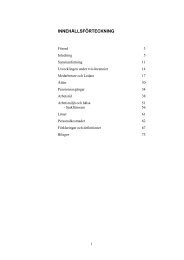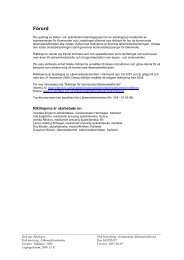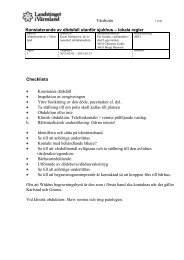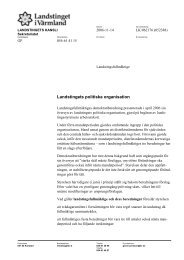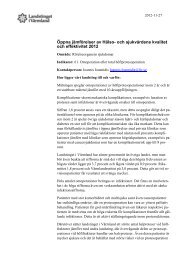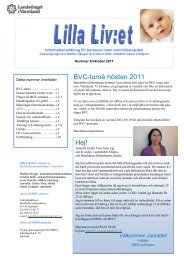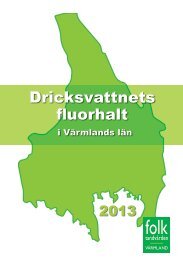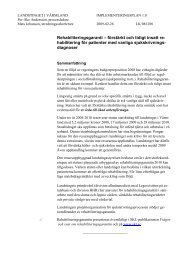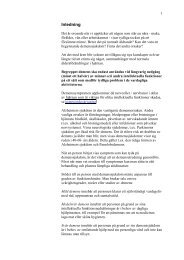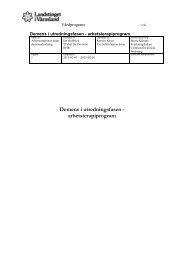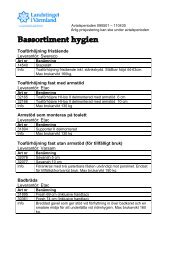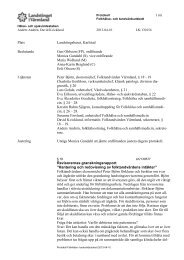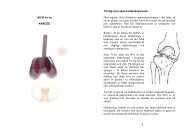Severs skada – paradigmskifte gällande diagnostik och behandling?
Severs skada – paradigmskifte gällande diagnostik och behandling?
Severs skada – paradigmskifte gällande diagnostik och behandling?
Create successful ePaper yourself
Turn your PDF publications into a flip-book with our unique Google optimized e-Paper software.
Perhamre et al.<br />
Mellion, 1996). Insoles of a molded plastizote orthosis,<br />
a heel cup to align pronation, or a heel wedge to<br />
reduce shear stress to the apophysis, are included in<br />
most recommendations (Micheli et al., 1987; Lutter,<br />
1992; Peck, 1995; Staheli, 1998; Kasser, 2006). Nonweightbearing<br />
with the lower limb immobilized in a<br />
short leg cast or a removable ankle orthosis worn<br />
during daytime is sometimes recommended (Lutter,<br />
1992; Ogden et al., 2004; Kasser, 2006). All studies<br />
are, without exception, observational studies.<br />
The purpose of this study was to find out if insoles,<br />
of two different types, without any other treatments<br />
or recommendations were effective in relieving heel<br />
pain in a group of 35 boys, 9<strong>–</strong>15 years of age,<br />
attending a Sports Medicine Clinic.<br />
Materials and methods<br />
The design in this experimental study was an intervention phase<br />
(4 weeks) with two randomized insoles, heel cup or heel wedge,<br />
and two non-treatment phases without insoles, one before and<br />
one after treatment, of 2 weeks, respectively (Fig. 1). Thirty-five<br />
boys were consecutively included with a median age of 12<br />
Intervention group, n=33<br />
Inclusion<br />
Nonintervention group, n=5<br />
Inclusion<br />
2 w<br />
4 w<br />
Heel cup<br />
Heel wedge<br />
2 w<br />
Randomisation End of<br />
study<br />
7-8 w<br />
Fig. 1. An experimental study in a group of boys with heel<br />
pain (n 5 33), with randomized types of insoles (heel wedge<br />
n 5 18, heel cup n 5 17). The cohort was followed for 2<br />
weeks in a pre-treatment phase, for 4 weeks in an intervention<br />
phase with insoles and for 2 weeks in a post-treatment<br />
phase, with no insoles. A separate consecutive series of<br />
patients in a ‘‘natural course group’’ was followed in 7<strong>–</strong>8<br />
weeks without insoles (n 5 5).<br />
820<br />
years (range 9<strong>–</strong>14 years). The patients were examined at the<br />
Sports Medicine Clinic for heel pain and were recruited during<br />
10 months. All the examinations were performed by the first<br />
author.<br />
Inclusion criteria were male gender, age 9<strong>–</strong>15 years, and a<br />
diagnosis of Sever’s injury. Findings confirming the diagnosis<br />
were tenderness over the calcaneal tuberosity and a positive<br />
compression test. Additional negative test results from the<br />
Achilles tendon and other parts of the hind foot were<br />
compulsory. Heel pain had to be present for more than 2<br />
weeks, but o26 weeks when examined. All participants were<br />
high-level athletes. Each patient had to specify two physical<br />
activities giving heel pain (here, named activity A and activity<br />
B), where the most painful activity was A. These two activities<br />
must be performed at least three times a week during the study<br />
period. Soccer was the dominating sports activity (n 5 28) in<br />
which the boys registered their pain, followed by running<br />
(n 5 22). In all cases where soccer was one of the choices, it<br />
was reported as the most painful activity. The median duration<br />
of pain on examination was 10 weeks (range 4<strong>–</strong>20 weeks).<br />
Eighteen of the boys were diagnosed with unilateral Sever’s<br />
injury, and 17 with bilateral. No previous treatment was given.<br />
Three boys fulfilling the inclusion criteria were not willing<br />
to participate in the study. Two boys dropped out of the study,<br />
one of them because he missed filling in the questionnaire, and<br />
the other because of a calf muscle strain (n 5 38).<br />
Borg’s CR-10 scale was used for measuring pain during<br />
activity A and B (Neely et al., 1992). Borg’s CR-10 scale is a<br />
self-assessment visual analog scale (VAS) with anchors of<br />
verbal explanations added to the numbers of the pain scale.<br />
Zero represents absence of pain and 10 represent maximal<br />
pain.<br />
Activity level was measured with Engstrom’s activity index<br />
(Engstrom, 2004) with five levels of activity, A<strong>–</strong>E. When<br />
included in the study, eight boys reported the second highest<br />
level D (strained to shortness of breath and sweating many<br />
times a week) and 27 boys reported the highest level of<br />
activity, E, (strained to shortness of breath and sweating every<br />
day or most days of the week) (Fig. 4).<br />
To study the natural course, we added a second inclusion<br />
period of 2 months with a consecutive series of patients with<br />
Sever’s injury, not using insoles, with the same inclusion and<br />
exclusion criteria (Fig. 1). The patients were examined at the<br />
Clinic, by the same person, in the same way as those in the<br />
cohort. Self-assessed pain recordings and activity levels were<br />
collected twice, at the start and at the end of the period. This<br />
group included five boys (median age 12 years, range 10<strong>–</strong>13<br />
years). One boy fulfilling the inclusion criteria was not willing<br />
to participate. Four of the boys were diagnosed with unilateral,<br />
and one with bilateral pain. The median time with<br />
symptoms was 14 weeks (range 6<strong>–</strong>26 weeks).<br />
In the experimental study, two alternative insoles, a heel<br />
wedge and heel cup, were used (Fig. 2). The heel wedge was a<br />
5-mm-cork wedge covered with a thin elastic surface. The<br />
purpose of the heel wedge was to lift the heel in the loading<br />
phase and thereby limit the shear stresses of the apophysis.<br />
The heel cup was a rigid plastic cup applied directly on the<br />
bare heel, with a moulded long arch support. It encloses the<br />
heel with a 2<strong>–</strong>3 cm brim. The purpose of the heel cup was to fix<br />
the heel pad directly below the calcaneal tuberosity during heel<br />
strike. Bilateral insoles were always used.<br />
After inclusion in the study, the boys were randomized by<br />
picking one ticket from a concealed box. Randomization<br />
resulted in a heel wedge group (n 5 18) and a heel cup group<br />
(n 5 17). During 2 weeks of pre-treatment, the pain questionnaire<br />
for pain related to the chosen sport activity was filled in<br />
six times for the two chosen activities A and B. No insoles<br />
were used. In the treatment phase of 4 weeks, when the insoles<br />
37



